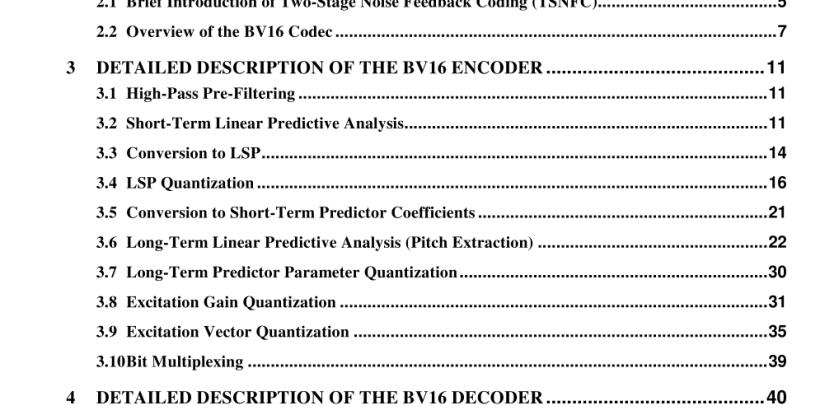ANSI SCTE 24-21-2017 pdf download.BV16 Speech Codec Specification for Voice over IP Applications in Cable Telephony
2.1 Brief Introduction of Two-Stage Noise Feedback Coding (TSNFC)
In conventional Noise Feedback Coding (NFC), the encoder modifies a prediction residual signal by adding a noise feedback signal to it. A scalar quantizer quantizes this modified prediction residual signal. The difference between the quantizer input and output, or the quantization error signal, is passed through a noise feedback filter. The output signal of this filter is the noise feedback signal added to the prediction residual. The noise feedback filter is used to control the spectrum of the coding noise in order to minimize the perceived coding noise. This is achieved by exploiting the masking properties of the human auditory system. Conventional NFC codecs typically use only a short-term noise feedback filter to shape the spectral envelope of the coding noise, and a scalar quantizer is used universally. In contrast, Broadcom’s Two-Stage Noise Feedback Coding (TSNFC) system uses a codec structure employing two stages of noise feedback coding in a nested loop: the first NFC stage performs short-term prediction and short-term noise spectral shaping (spectral envelope shaping), and the second nested NFC stage performs long-term prediction and long-term noise spectral shaping (harmonic shaping). Such a nested two-stage NFC structure is shown in Figure 1 below.
In Figure 1 above, the outer layer (including the two short-term predictors and the short-term noise feedback filter) follows the structure of the conventional NFC codec. The TSNFC structure in Figure 1 is obtained by replacing the simple scalar quantizer in the conventional (single-stage) NFC structure by a “predictive quantizer” that employs long-term prediction and long-term noise spectral shaping. This “predictive quantizer” is represented by the inner feedback loop in Figure 1, including the long-term predictor and long-term noise feedback filter. This inner feedback loop uses an alternative but equivalent conventional NFC structure, where ) (z N l represents the filter whose frequency response is the desired noise shape for long-term noise spectral shaping. In the outer layer, the short-term noise feedback filter ) (z F s is usually chosen as a bandwidth-expanded version of the short-term predictor ) (z P s . The choice of different NFC structures in the outer and inner layers is based on complexity consideration. By combining two stages of NFC in a nested loop, the TSNFC in Figure 1 can reap the benefits of both short-term and long-term prediction and also achieve short-term and long-term noise spectral shaping at the same time. It is natural and straightforward to use a scalar quantizer in Figure 1. However, to achieve better coding efficiency, a vector quantizer is used in BV16. In the Vector Quantization (VQ) codebook search, the ) (n u vector cannot be generated before the VQ codebook search starts. Due to the feedback structure in Figure 1, the elements of ) (n u from the second element on will depend on the vector-quantized version of earlier elements. Therefore, the VQ codebook search is performed by trying out each of the candidate codevectors in the VQ codebook (i.e. fixing a candidate ) (calculating the corresponding )
The TSNFC decoder structure is simply a quantizer decoder followed by the two feedback filter structures involving the long-term predictor and the short-term predictor, respectively, shown on the right half of Figure 1. Thus, the TSNFC decoder is similar to the decoders of other predictive coding techniques such as Adaptive Predictive Coding (APC), Multi-Pulse Linear Predictive Coding (MPLPC), and Code-Excited Linear Prediction (CELP). If the alternative NFC structure in the inner feedback loop of Figure 1 is also used in the outer feedback loop, an alternative TSNFC codec structure is obtained, as shown in Figure 2 below. Here ) (z N s represents a short-term filter whose frequency response is the desired noise shape for short-term noise spectral shaping. The codec structure in Figure 2 is mathematically equivalent to the structure in Figure 1, but it allows direct specification of the short-term noise spectral shape as defined by ) (z N s . This can be an advantage in some applications.ANSI SCTE 24-21-2017 pdf download
